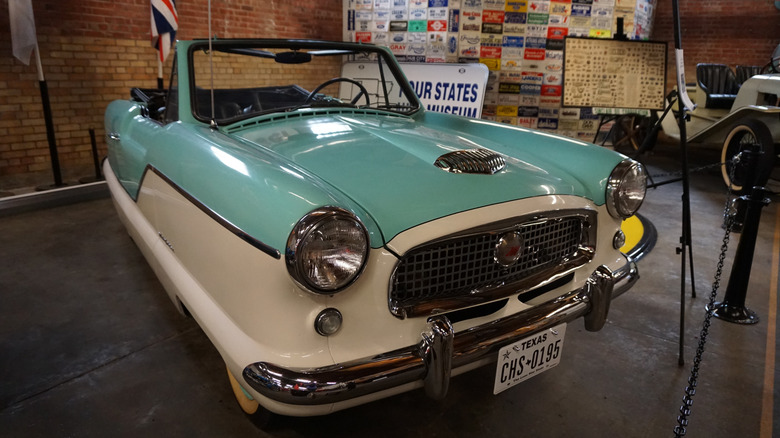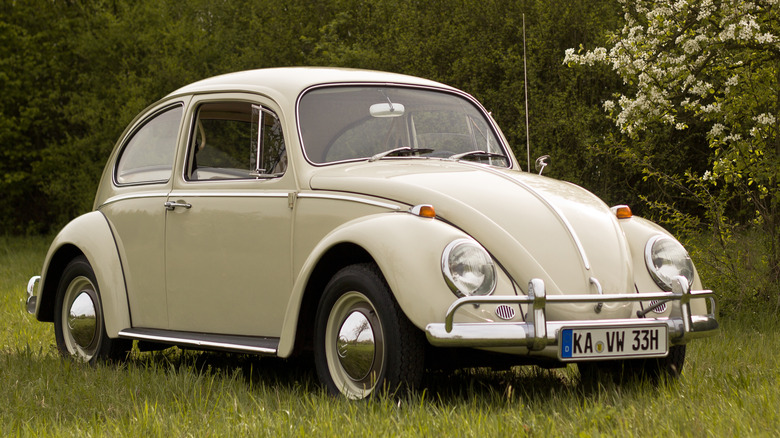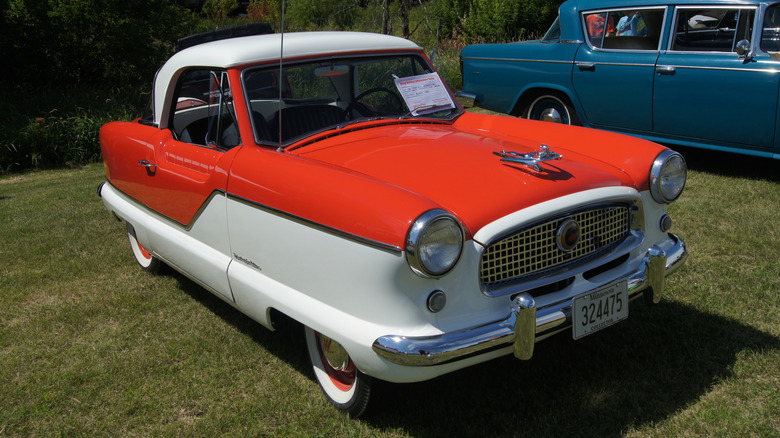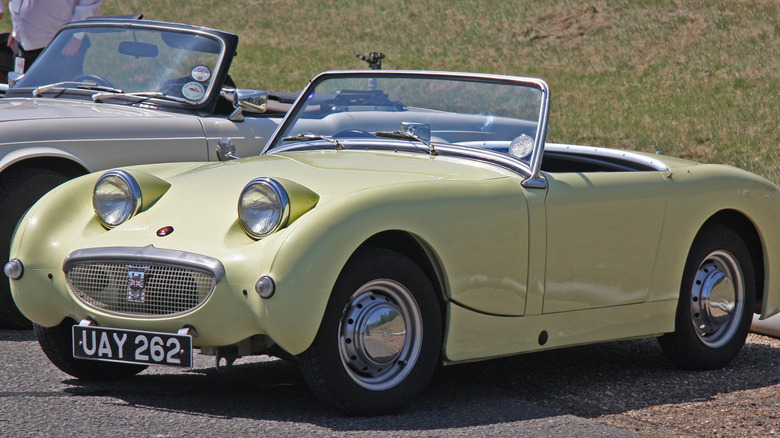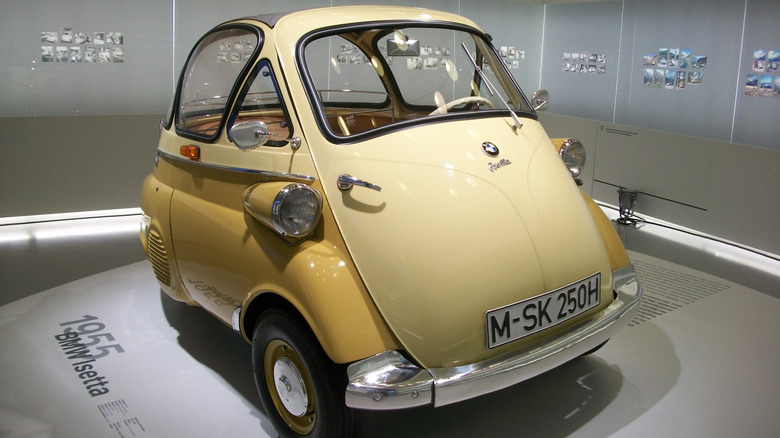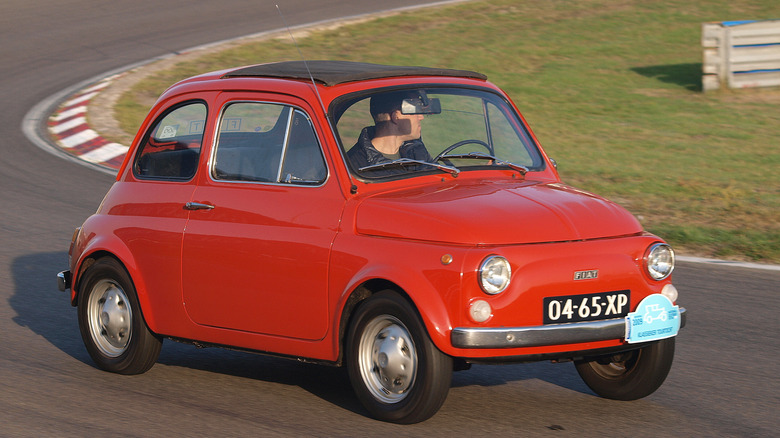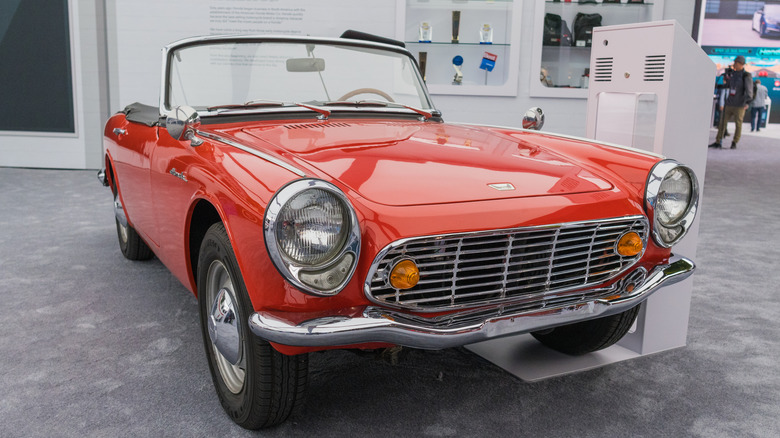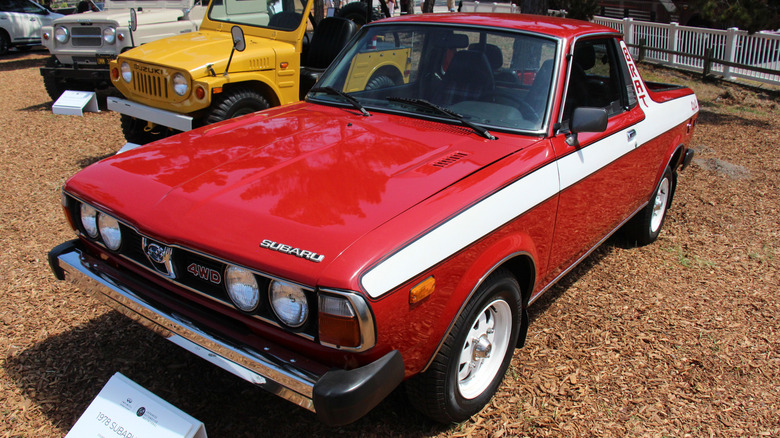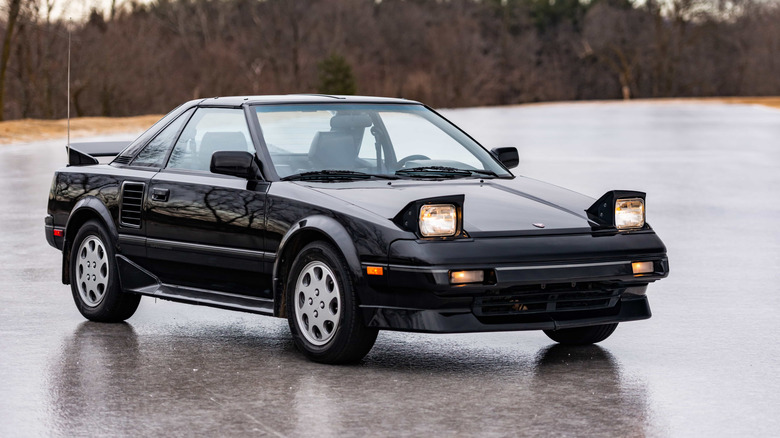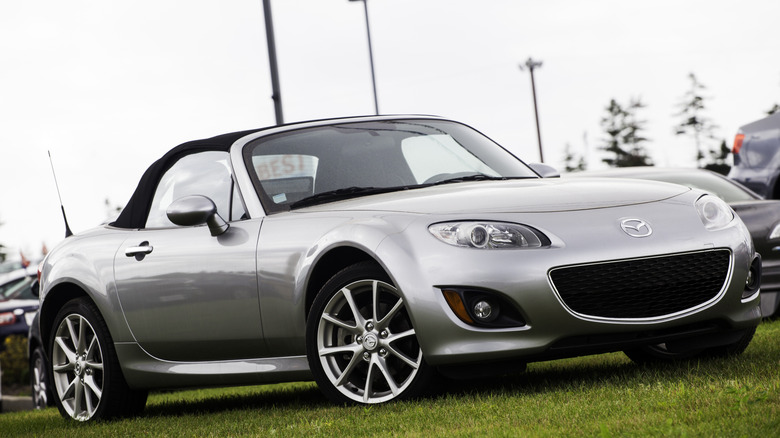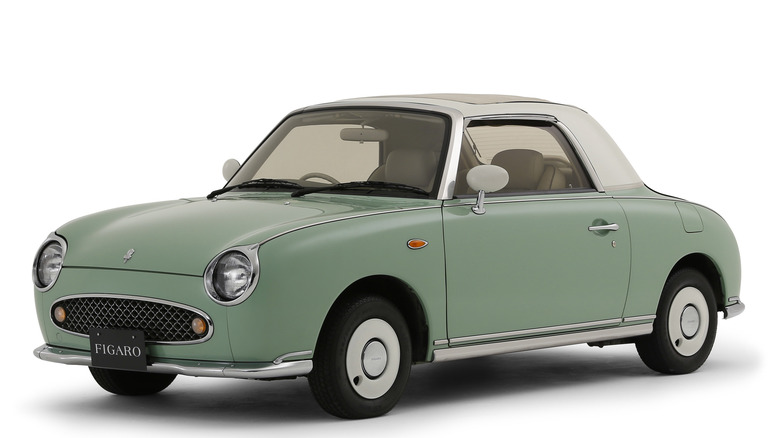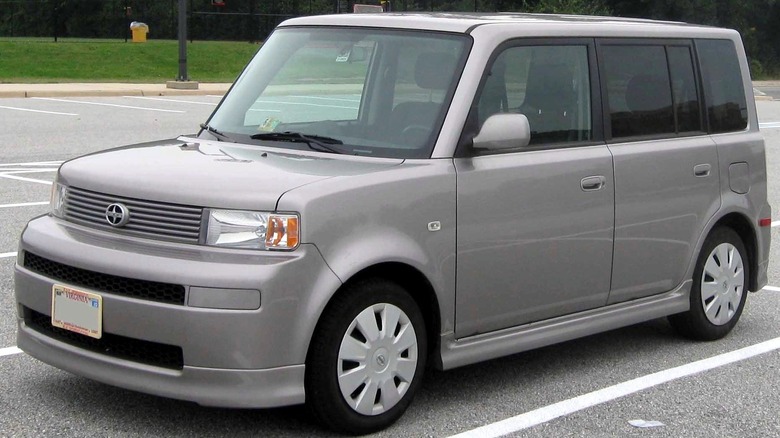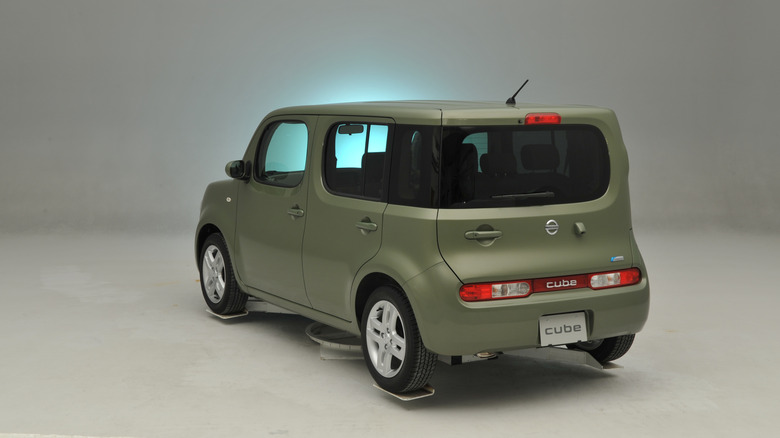12 Of The Cutest Cars Ever Made
The earliest cars were very utilitarian-looking. The first car ever invented, patented by Carl Benz in 1887, was little more than a bench, a wooden floorboard, three bicycle-style wheels, and a one-cylinder engine mounted on the back. Once the new "horseless carriage" technology matured, however, cars quickly became a canvas for dreams. They could display any aesthetic their designers imagined: voluptuous, streamlined, muscular, low-slung, or just plain practical. They could even be cute. But what makes a vehicle cute? After all, it's just a machine for getting from one place to another.
Cute implies personality, as if the car is alive. By comparison, most adjectives used to describe cars are exactly that: descriptive. But a small number of adjectives go beyond description to suggest something almost like a personal relationship between car and driver. "Sexy" would be one of those adjectives, and "cute" would be another, although it's unlikely both words would ever describe the same car. "Sexy" sounds like it would get you in trouble, whereas "cute" sounds like an adorable puppy or a favorite stuffed animal.
And that's where we begin to see what traits make a car cute. A cute car is usually small, for one thing. This gives it scaled-down proportions and makes various elements like headlights seem larger by comparison. This taps into our mammalian caregiving response, since babies of many species (including our own) display features such as disproportionately large eyes and stubby limbs. It helps that many of the cutest cars even seem to have faces, as the list below shows. So while a knee-high exotic Italian supercar or an American muscle car with bulging flanks may set pulses racing, cute cars make us want to give them names and keep them forever.
1938-2003 Volkswagen Beetle
The original Volkswagen Beetle runs the risk of being too familiar to stand out as cute, but there's no denying that its proportions almost perfectly exemplify cuteness. Heck, one of the cool and unique features of the Beetle was a flower vase that could be fitted to the dashboard — and how cute is that? It was so cute that there was even a movie starring a Beetle named Herbie called "The Love Bug." In this 1968 film, a sentient Beetle wins hearts and races. The filmmakers were very aware of the Beetle's anthropomorphic features: big headlights that look very much like eyes flanking a hood bulge that looks like a nose, all underlined by a bumper that looks like a mouth.
The overall proportions of the Beetle are cute, too. Its small dimensions and rounded profile are nearly the Platonic ideal for a small car design. In the U.S. in particular, this diminutive vehicle stood out against a sea of giant Detroit cars. Perhaps its appearance helps explain why it remained in production for 65 years, selling in the tens of millions. Its popularity with hippies in the 1960s gave it even more of an aura of peace-love-and-happiness, making it seem as friendly as it is cute.
1954-1962 Nash Metropolitan
Like the Beetle, the Nash Metropolitan also bucked the trend of automotive gigantism. It almost resembled a cartoon version of a 1950s American car with its tiny dimensions, slab-sided styling, covered wheel openings, and diminutive tailfins. In fact, the Metropolitan inspired the car driven by Bob Parr, the secret identity of Mr. Incredible, in the Pixar animated movie "The Incredibles," albeit with a modern hatchback roofline. Bob crammed his gigantic superhero frame into the tiny car for maximum comedic effect. A real-life strongman would probably have had similar trouble getting into a Metropolitan, given that it was America's first subcompact car at only 149.5 inches in length. By comparison, a 1954 Buick Roadmaster was over 216 inches long.
The Metropolitan was even shorter than the Beetle by almost a foot. The reason for its small size lay under its adorably stubby body panels since it was built using components from the British manufacturer Austin, known for manufaturing diminutive roadsters and the original Mini. Austin supplied the car's four-cylinder engines, too. Nash applied the Metropolitan's distinctively American bodywork, which came in both coupe and convertible forms. The car was available in the two-tone color schemes that were popular at the time, making it look even more like a cute, miniaturized version of classic Detroit iron.
1958-1961 Austin-Healey Sprite
If you know your British roadsters, then you absolutely knew this car would make this list. The Austin-Healey "Bugeye" Sprite could easily rank as the cutest car in history because of its insanely adorable face. Also nicknamed the "Frogeye" in its native British Isles, even if the Sprite wasn't the cutest car of all time, it was certainly one of the happiest-looking cars ever made. Every generation of the Sprite was cute, particularly the Sprite Mark I, built between 1958 and early 1961. Its headlights stuck up prominently from a hood that sloped down to a smile-shaped grille. This, combined with its tiny size and oversized wheel arches, made it look almost like a child's pedal car.
Unlike a kiddie car, though, the Sprite had a choice of inline four-cylinder engines powering the rear wheels through a four-speed manual transmission. With either 42 or 52 horsepower, the 0-60 run took 20 long seconds. Handling took precedence over speed; its innovative monocoque body boosted the little roadster's rigidity, lacking even a trunk in order to maximize chassis stiffness. Any luggage that couldn't be strapped to a rack on the rear had to stay at home. The Sprite was so spartan that it even lacked exterior door handles. Yet it offered cuteness and charm in spades.
1955-1962 BMW Isetta
The Isetta saved BMW from bankruptcy during the post-war scarcity of its time. As such, this bubble car has something of a dark side beneath its tiny and cute exterior, like a starlet with a tragic past. Yet the microcar went on to become an icon. BMW needed a high-volume model to combat declining sales and the expense of building its luxury models, so it licensed the design for the Isetta from Iso Rivolta, an Italian manufacturer of cars and refrigerators. (Because of course those two things go together, right?) The name Isetta is a diminutive for Iso, so even the car's name is friendly and cute.
At first glance, you might notice the door handle on the front of the car; the whole front opens like, well, a refrigerator. The driver just has to step around the steering wheel and drop into the car's bench seat. A passenger could join the driver, although in these cramped quarters, it was best if they quite liked each other. A canvas roof provided an emergency exit if the door got stuck in a front-end collision. In the model's first year, the engine boasted all of one cylinder that generated precisely 12 horsepower. A larger engine in 1956 bumped that to 13. But that was good for speeds of up to 53 mph, and a rack on the back could carry luggage, so the Isetta sold over 160,000 units in eight years.
1957+ Fiat 500
Many of the cars on this list had one or two generations that stood out as particularly adorable, but the iconic Fiat 500 has displayed its feisty Italian cuteness from day one. From the original 500 that debuted in 1957 to the electric Fiat 500e that came back to America for the 2024 model year, this iconic little car has served generations of drivers as the ultimate urban runabout. Through all the decades, one common thread has united every model of the Cinquecento (that's 500 in Italian): this little car is darn cute.
Much of this cuteness comes from its minuscule proportions. Almost any car this small might make you go awww. But from one model year to the next, the 500's designers have always given it an expressive and outsized personality. The first generation looked almost like a rolling bowler hat. In more recent years, the 500 has adopted an aggressive stance, with fender flares and a hatchback profile that make it look almost like it's leaning forward, like a small dog ready to rumble. Recent 500 convertible models have roofs that fold back over the tiny tailgate like a hoodie. All told, the seven-decade history of the 500 is a history of cuteness.
1964-1966 Honda S600
The Honda S600 was more than just a tiny roadster that can still make onlookers squeal with delight; it marked a turning point for the Honda Motor Company as it transitioned from a motorcycle maker into what would become one of the world's great car manufacturers. Technically, it wasn't Honda's first production model; that was its predecessor, the S500, of which only 1,300 were built. But the S600 was the company's first volume passenger car model. It was absolutely minuscule at only 130 inches in length and 55 inches in width — 24 inches shorter and 13 inches narrower than a 2025 Mazda MX-5 Miata.
Yet, despite its size, its proportions are nearly perfect. It features sporty lines and a slight arch to the rear quarter panels that give it a spirited posture. In photos, only the outsized headlights and windshield tip you off to the car's small size. In person, of course, it's almost astonishingly small, even in comparison to modern roadsters. Honda's designers did an excellent job on their first try, creating a scaled-down but very attractive car, which most people would agree is also very cute. With independent suspensions front and rear, an all-aluminum engine generating almost 100 horsepower per liter, and a 9,500-rpm redline, this little car could scoot around pretty well, too. Today, it's considered one of the best-looking Honda models of all time.
1978-1987 Subaru Brat
The Subaru BRAT's full name — the Bi-drive Recreational All-terrain Transporter – is absurdly large for this tiny and oh-so-cute pickup. Subaru adapted its Leone station wagon into a mini-truck in response to the growing popularity of compact pickups in the 1970s. The BRAT debuted in 1978 and sold worldwide until 1994, but in the U.S., it was discontinued after 1987. As if the BRAT wasn't cute enough with its jaunty little body, in the States, it was sold with a pair of rear-facing jump seats in the bed, back-to-back with the cab, giving it somewhat of a dune buggy aesthetic.
These rear seats helped the BRAT evade tariffs on imported pickups by posing as a passenger car, but the beachy cachet they gave the BRAT was a happy accident. Standard four-wheel drive made it even more of a favorite among outdoorsy types, including President Ronald Reagan. The BRAT sold 100,000 units in the U.S. during its decade-long run, but eventually, declining sales caused Subaru to discontinue its little pickup truck. The value of a BRAT today might surprise you, with good-condition examples selling for far more than they were worth when new.
1984-1989 Toyota MR2 (First Generation)
Even the Toyota MR2's nickname — the Mister Two — is crazy cute. Every generation of the Mister Two is arguably cute, but the first generation pegged the cuteness meter. There's some confusion about what the MR2 abbreviation means, with some sources claiming it stands for "midship runabout 2-seater," while Motor Trend says it means "MidshipRear-drive 2-seater." The truth has probably been lost to legend, but one thing is definite: the MR2 was a fun car to drive.
The first generation of the MR2 was also completely cute. Its wedge-shaped form factor could be seen on other cars of the 1970s and 1980s like the Triumph TR7 and the Pontiac Fiero, but the Mister Two arguably pulled it off best. There's just something right about its proportions and its nicely integrated body elements, such as the bumpers. Nothing stands out as jarring or tacked-on. Some MR2s had a saucy little wedge-shaped spoiler that mirrored the overall shape of the body. Available t-tops turned it into a great ride for a beach day. With great handling and fun-in-the-sun potential, the Mister Two was more than just cute.
1989-2015 MX-5 Mazda Miata (First Through Third Generations)
The first three generations of the Mazda MX-5 Miata presented an aw-shucks grin to the world, like a baby-faced star who never seems to grow old. By the time its fourth generation arrived in 2016, it had adopted a more angular and aggressive styling language; the star had grown up and matured. But those first three generations between 1989 and 2015 — oh, were they ever so cute. The first generation had retractable headlights, but the combination of the parking lights and the mouth-shaped air intake in the front bumper gave the Miata the look of a crinkly-eyed smile, or a newborn kitten whose eyes hadn't fully opened yet. The second generation in 1999 and the third generation in 2006 featured regular headlights, giving the little roadster more of an open-eyed smile, but it was still as cute as a button.
Being available in colors like bright red or sunburst yellow just upped the adorable factor. No matter how many Miatas one saw on the road, it was always something special. Amid a sea of sensible sedans and the ever-growing number of imposing SUVs, the Miata was like a ray of sunshine rolling down the road. The fact that the Miata is an excellent driver's car and one of the best Mazda models of all time is best appreciated from behind the wheel, but everyone can enjoy the reflected glow of the joy it radiates.
1991 Nissan Figaro
The Nissan Figaro's retro mid-century looks could give the Austin-Healey Sprite a run for the title of the cutest car in history, with its appeal only heightened by the fact that it was produced for only one year. It was also a Japanese domestic market (JDM) model, so it may be less familiar to readers in North America. Even in Japan, it's one of the rarest JDM cars of all time, limited to just 20,000 units. It was one of the first retro-styled cars, with its rounded lines, plentiful use of chrome, and colors like Pale Aqua all recalling the Jet Age cars of the 1960s. Yet somehow, it managed to be cuter than anything from that era — or its own time, for that matter.
Part of this is attributable to those cartoonishly rounded lines, and part of it results from the "face" created by its huge headlights and grille. Its friendly visage almost gives the folding white hardtop roof the look of a hat. It's just that charming. Its white leather interior featured specially designed instruments for extra panache. The Figaro exuded cuteness both inside and out.
2004-2007 Scion xB (First Generation)
Ask a child to draw a car, and there's a good chance the result will look like the first-generation Scion xB. It was nearly the Platonic ideal of a two-box car design, featuring almost nothing but right angles on its exterior. And yet, somehow, it worked. What's more, the first-gen's protruding and very tall front bumper made the xB look like it was leading with its chin. Scion was Toyota's youth brand, or at least that was Toyota's plan, but the xB almost looked like an oh-so-serious older man harrumphing as he went about his business. It was arguably the most memorable model from Scion's 14-year existence.
The xB was a hit with tuners, who got a kick out of turning the frumpy little block-shaped car into all kinds of unlikely and imaginative forms. Even today, a search for "Scion xB tuner" will turn up hundreds of sites ready to make the xB into its owner's personal canvas. Scion sold 61,000 of them in the first generation's best year, 2006. But then came a redesign for 2008, with the severe right angles rounded off, giving the new xB a more conventional 21st-century look. The new model also gained size and quite a bit of weight. The tossable driving dynamics of the subcompact first-generation model disappeared, along with the charm, and sales plummeted to a third of what they had been. It was a rare marketing miscue by Toyota.
2009-2014 Nissan Cube
The Nissan Cube demonstrates that there's an uncanny valley between cute and strange, with its rounded side windows and asymmetrical rear windshield and door. Yet, ultimately, its earnest adorableness wins you over like that last puppy to get adopted. When it hit the U.S. market in 2009, it had already been a cult classic in Japan for years. The Cube resonates with Japanese design motifs, which tend to avoid symmetry, favoring a look that reflects the way things grow in nature. It polarized observers in the U.S., with some loving it and others feeling it was one of the strangest cars made in the 2000s.
The style elements that make the Cube cute are its rounded lines, including the side windows, the headlights that look almost like spectacles, and rear sheet metal that curves outward into the bumper, giving the Cube a pert little protruding butt. Nissan itself described the Cube as looking like a "bulldog in sunglasses." And then there was that show-stopping rear door; there was nothing else like it on the automotive market. It wasn't just a style feature, though: the side-hinged door swung wide open to give easy access to the Cube's surprisingly large interior. In the Cube's case, cute followed function.
